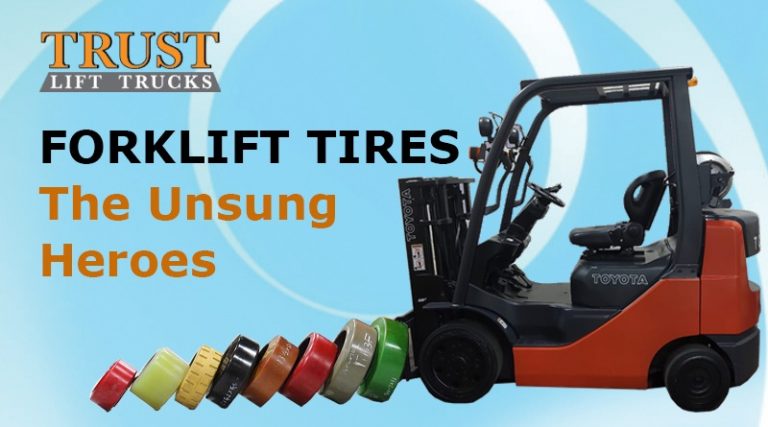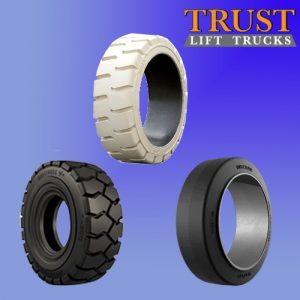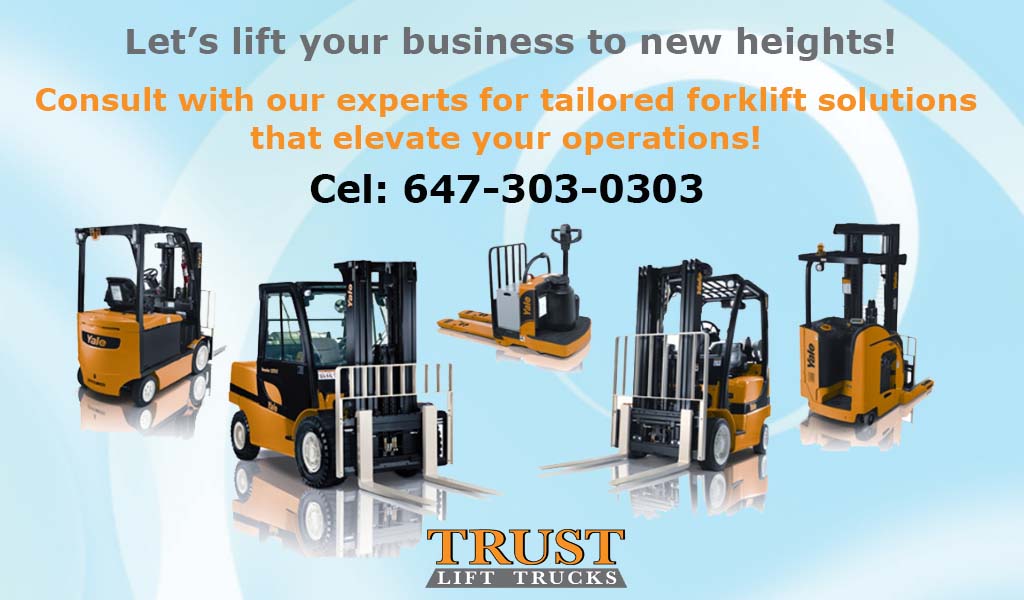Forklift Tires: The Unsung Heroes

Often overlooked in the grand scheme of warehouse operations, forklift tires are the unsung heroes that keep the supply chain moving. These seemingly simple components play a critical role in ensuring safety, productivity, and the overall efficiency of your warehouse. It is important to know that the tires used for electric and propane forklifts are the same.
The Right Tire for the Right Job
Just like a race car needs specialized tires to conquer the track, forklifts require specific tires to excel in their demanding environments. The type of tire you choose depends on a variety of factors, including:
Floor Type: Smooth concrete floors, rough warehouse floors, or outdoor terrain will dictate the type of tire needed.
Load Capacity: Heavier loads require tires with robust construction and superior traction.
Operating Environment: Indoor or outdoor use will influence the tire’s resistance to wear and tear.
Common Types of Forklift Tires
1- Pneumatic Tires:
- Offer excellent shock absorption and traction, making them ideal for outdoor and uneven indoor surfaces.
- Require regular air pressure checks to maintain optimal performance.
- 2- Solid Tires:
- Puncture-resistant and durable, solid tires are perfect for indoor applications on smooth floors.
- Can be noisy and less comfortable for operators.
- 3- Cushion Tires:
- A hybrid of pneumatic and solid tires, offering a balance of comfort and durability.
- Well-suited for indoor applications on smooth floors.
4- Polyurethane Tires:
- Non-marking and highly durable, polyurethane tires are ideal for cleanroom environments and food processing facilities
- Provide excellent traction and resistance to cuts and tears.

Tire Maintenance: A Key to Longevity
Proper tire maintenance is essential to maximize their lifespan and performance. Here are a few tips:
- Regular Inspections: Check for signs of wear, damage, or uneven wear patterns.
- Air Pressure: Maintain optimal air pressure to ensure proper traction and handling.
- Rotation: Rotate tires periodically to distribute wear evenly.
- Storage: Store tires in a cool, dry place away from direct sunlight.
- Professional Alignment: Periodically align your forklift to prolong tire life and improve handling.
Traction Tires: A Grip on Warehouse Efficiency
Traction tires are a critical component of forklift safety and efficiency. Designed to provide superior grip, even in challenging conditions, they play a vital role in preventing accidents and maximizing productivity.
Why Traction Matters
- Safety: Good traction reduces the risk of slips, skids, and rollovers, especially on wet or uneven surfaces.
- Efficiency: Improved traction allows for smoother operation and faster load handling, boosting productivity.
- Reduced Wear and Tear: Proper traction reduces stress on the forklift’s components, extending their lifespan.
Factors Affecting Traction
Several factors influence a forklift’s traction:
- Tire Material: The type of material used in the tire’s construction significantly impacts its grip. Rubber compounds with high-quality additives offer superior traction.
- Tread Pattern: The design of the tread pattern determines the tire’s ability to disperse water and debris, ensuring optimal contact with the surface.
- Tire Pressure: Maintaining the correct tire pressure is essential for maintaining proper traction and preventing premature wear.
- Floor Conditions: The condition of the warehouse floor, whether it’s wet, oily, or uneven, will affect the required level of traction.
Choosing the Right Traction Tires
-
When selecting traction tires for your forklifts, consider the following factors:
- Operating Environment: Indoor or outdoor use, smooth or uneven floors, and temperature extremes will influence the tire’s performance.
- Load Capacity: Heavier loads require tires with deeper tread patterns and stronger construction.
- Maneuverability: Tires with good maneuverability are essential for tight spaces and frequent turns.
- Cost: Balance the initial cost of the tires with their long-term benefits, such as increased productivity and reduced downtime.
By investing in high-quality traction tires and implementing proper maintenance practices, you can significantly improve the safety and efficiency of your warehouse operations.
Conclusion
By understanding the different types of forklift tires and implementing proper maintenance practices, you can significantly improve the safety, efficiency, and overall productivity of your warehouse operations. Don’t underestimate the power of these often-overlooked components. Please be reminded that Trust Lift Trucks knowledgeable staff are ready to assist you in selecting the right tires for your forklift according to your specific applications. We are just a call away from you in Toronto and GTA. We can also advise you to rent or buy a forklift based on your requirements.
